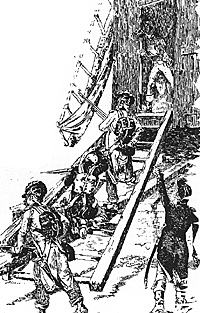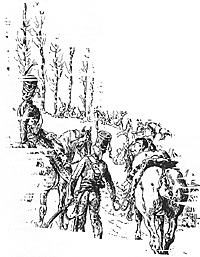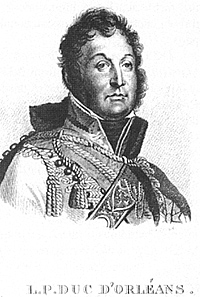Battle of Swalmen 1793
Dutch During the
Revolutionary Wars Part 12
The Battle
by Geert van Uythoven, Netherlands
| |
Arriving at the brook, the Prussian immediately began to construct the bridge they had brought with them, covered by the Schützen. While constructing the bridge, the whole 2nd Column arrived, still on the north bank of the brook! Instead of turning the French positions at Swalmen as had been ordered, the 2nd Column had not crossed the brook, and taken the collateral road to Swalmen. When the bridge was ready the infantry of the 2nd Column crossed the Swalm first and deployed in front of the entrenchments southeast of Swalmen, receiving casualties from the lively French fire. At the same time, the cavalry forded the brook, and also deployed. After their deployment the infantry advanced somewhat, making room for the 1st Column to cross the bridge also. During their deployment, the infantry was charged by French cavalry, but this feeble attack was immediately thrown back by their Prussian counterparts. The Grenadier-Bataillon von Malschitzky had returned from Bessel and rejoined the main force of the 1st Column. It also crossed the bridge and deployed to the right of the 2nd Column, in front of the fortifications of Swalmen. So, in spite of the Duke of Brunswick-Oels’ plan to outflank the French positions, both columns were now deployed in front of the French entrenchments, with the infantry battalions of the 2nd Column in full view of the French, receiving serious casualties. For this reason an attack could no longer be postponed. Lieutenant-General Knobelsdorf and Major General von der Goltz decided that the 1st Column would attack first.
But again things went wrong for the Prussians. Lieutenant-Colonel von Nyvenheim attacked prematurely, before the battalions of the Regiment No. 27 von Knobelsdorf even started their advance, apparently hurried by the fire they had to sustain without being able to reply! As a result, they received the whole attention of the French in their entrenchments, and were caught in a heavy crossfire. Decimated by grape-shot, the battalion received heavy losses. Its commander, Lieutenant-Colonel von Nyvenheim, was killed, Captain von Taubenheim wounded, as was Lieutenant von Wussow, who would also die of his wounds later. The attack faltered. But by now the Regiment No. 27 von Knobelsdorf advanced. It was also met by the French with a musket volley, but in spite of this the leading Prussian grenadiers kept order, halted and returned fire, firing several well placed volleys. The French morale broke and they abandoned the village, retreating back to some entrenchments. But they were soon dislodged again when enfiladed by a 6-pdr gun. By now the 2nd Column resumed their advance, also capturing the entrenchments in front of their position. The 1st Musketier-Bataillon and the Depot-Bataillon of the Regiment No. 44 von Kunitzky, continued the advance and also captured Hillenrädt Castle. The French retreated back to Roermond, destroying all bridges across several wide ditches behind them, thus preventing any effective pursuit. The 3rd Column began its advance 07.00 am, leaving Dulcken in the direction of Krüchten. It had however to make some detours because of the inundated terrain, and reached the Swalm brook somewhat more north, near the hamlet Brempt. Quickly a bridge was thrown over the brook, over which the infantry crossed. The cavalry crossed somewhat further upstream, using a ford. Arriving on the opposite bank, the Duke of Brunswick- Oels, who as we have seen accompanied this column, learned from a patrol that the French had abandoned both Krüchten villages and Brüggen the same morning, and had retreated to Roermond. The Duke until now had received no news about what was going on at Swalmen, Arsbeck and Wassenberg. The storm prevented any gunfire to be heard. Being in the dark about what the best direction would be to move his troops, he decided to send a strong reconnaissance along the road to Roermond, which had to set up outposts near the village Elmpt, while he remained at Brempt, sending out officers to the expected positions of the other columns to ascertain what was going on. The reconnaissance force consisted of both Austrian uhlan squadrons and the
squadron of the Husaren Regiment No. 8 Graf von der Goltz, commanded by
Colonel Gebhart Leberecht von Blücher. [4]
Completely in the line of his
character, arriving near Elmpt, Colonel von Blücher heard the guns at Swalmen
and immediately moved with his whole force that way, abandoning Elmpt.
The Duke of Brunswick-Oels, still waiting for news, took up defensive
positions with the troops at his disposal. The Grenadier-Bataillon von
Hagken occupied the village Niederkrüchten.
The bridge near Brempt was protected by Schützen, and the half
battery deployed on a height near Brempt. The remaining troops stayed
on the east bank of the Swalm brook. Finally, the Duke received message
from the 4th and 5th Column, that these had taken their objectives
Arsbeck and Wassenberg, without meeting any opposition. Immediately
after receiving this news, Lieutenant von Schulenburg from the hussars
arrived, send by Colonel Grenadier-Bat.(von Hagken) / Rgt No. 48 von
Köthenon Blücher, telling the Duke that the French held out at Swalmen,
and that Major General von der Goltz asked for assistance. Also learning that
Von Blücher had abandoned his positions at Elmpt, the Duke immediately
ordered the Grenadier-Bataillon von Hagken to advance and to occupy
that village. All remaining troops crossed the Swalm brook and concentrated
near Brempt.
However, before the Duke of Brunswick-Oels started his advance, another courier arrived
from Major General von der Goltz, bringing message that Swalmen had
been captured after heavy fighting, support not necessary anymore.
Further north, near Arcen, Major Blomberg had engaged the French
battery on the opposite bank of the Meuse. The result however was not
clear. The 3rd company of the Grenadier-Bataillon von Blomberg guarded
the east bank of the river Meuse between Bessel and Venlo, and
prevented an attempt by French infantry to cross the river. According
to the Prussians, the crossing was attempted to attack the Prussians
advancing to Swalmen from behind.
This is however not very probably, because this French force was very
small. Probably it was only a reconnaissance, not related to the fighting further south.
In Venlo itself, as ordered, at break of day Major General von Pirch
started bombarding the fortress St. Michel on the opposite river bank. After a few moments the French artillery, consisted of five 8-pdr and 12-pdr guns, four howitzers and two
heavy 80-pdr mortars, replied. Their fire was heavy, but aimed at the city
Venlo itself, and not at its walls or the Prussian artillery positioned there. As
a result the Prussian lost not a single man or gun there, while the city was
severely damaged. Prussian sources state that not one house stayed undamaged.
Inside the city, an artillerymen and a soldier were killed while bringing
ammunition to the guns, several others were wounded. In addition a
French émigré and a citizen were killed. Several fires were started by the
French bombardment, but they all were quickly extinguished by the
citizens. Around noon the French fire gradually ceased, Major-General von
Pirch believing that his own bombardment had disabled all French guns.
Therefore he decided to cross some infantry over the river, to capture the
fortress St. Michel. This force was composed of twenty Dutch soldiers
and forty Prussian volunteers. While these were collecting, preparing a
flying bridge to cross, the French opened fire with a number of guns,
scattering the attack force without loss, but sinking the flying bridge. The
Prussian guns replied, and both sides continued firing during the afternoon,
until 16.00 pm, when the French fire again fell silent. Prussian fire ceased
around 17.00 pm.
The Duke of Brunswick-Oels designated the places his troops would
have to stay during the night. The 1st Column returned to Bessel and bivouacked
there. Of the 2nd Column, as described, the Grenadier-Bataillon
Nyvenheim suffered heavy casualties in the attack at the Swalmen position,
and therefore was to occupy Swalmen, to be able to collect and treat their
wounded. The Depot-Bataillon / Regiment No. 44 von Kunitzky occupied
Hillenrädt Castle. The remaining units of the 2nd Column bivouacked
near Brüggen. The 3rd, 4th, and 5th Column bivouacked at the objectives
they occupied. The 3rd and 4th company of the Grenadier-Bataillon
von Blomberg moved to the villages Tegelen and Belfeld, south of Venlo.
The cavalry performed outpost duty, on the banks of the Meuse and the
Swalm brook. In addition, they maintained communications with Venlo.
After having forced the French defences along the Swalm brook on 3 March, the Duke of Brunswick-Oels
planned to attack Roermond itself. However, the Duke was informed by FZM Clerfayt that Major General von
Wenkheim with his Austrian units, in order to secure the flank of the Austrian
advancing army, and in co-operation with the troops of FML von
Latour, would have to attack the village Vlodrop which was fortified
and occupied by the French.
In addition, the Duke was asked to support this attack with Prussian troops. With
his forces so substantially weakened by detaching these troops, the attack
on Roermond had to be postponed. Lieutenant-General von Kossboth with
his Prussians was ordered to support General von Wenkheim in his attack.
The Prussians held the positions that were assigned to them immediately
after the battle. The village Bessel, on the east bank of the river Meuse, north
of Swalmen, was occupied by both musketeer battalions of Regiment No.
27 von Knobelsdorf, commanded by Lieutenant-General Alexander Friedrich
von Knobelsdorf.
On the west bank of the river Meuse, opposite the village Bessel,
the French placed numerous guns, and during the whole day Bessel was bombarded
by them. The French also tried a few times to cross the Meuse with infantry in huge
barges, under cover of their artillery, but every time their attack was beaten off.
Major-General von Pirch reported that on the west bank of the
river Meuse French columns were seen moving south. Therefore, the Duke of
Brunswick-Oels wanted to be prepared for more French efforts to cross the
Meuse, even with stronger forces. To be prepared for such an eventuality
more Prussian units were send to the Meuse: the 1st Musketier-Bat. / Regiment No. 44 von Kunitzky, and
two more squadrons of the Husaren Regiment No. 8 Graf v.d. Goltz.
Southwest of Roermond, General von Wenkheim had captured the
fortified village Vlodrop on the 4th, the French thrown back in Roermond.
On the same day, FML von Latour moved with the troops at his disposal
from Sittart north to Linne, clearing away the French from the east bank of
the Meuse, driving them across the river or back on Roermond. The
French, commanded by maréchal de camp de la Marlière, apparently did
not want to give up Roermond easily, and substantial reinforcements of
infantry and artillery arrived in the city. The defence work of Roermond
were in a sorry state. The French had done their best to reinforce these with
entrenchments. Nevertheless, the Duke of Brunswick-Oels planned to attack
the city on the 5th, now the forces that had taken part in the attack on Vlodrop
were available again.
The main Prussian force deployed east of Roermond on the height between
Maasniel and Gebroek. The right wing was secured by the Prussian the
Prussians near Swalmen and those occupying Hillenrädt Castle. The left
wing was secured by the Austrians commanded by FML von Latour and
Major General von Wenkheim. The main attack would be executed on the
Schwarzbrucher Gate by Major General von Wenkheim with the
Austrian troops under his command. This attack would be supported by
Prussian units commanded by the Duke himself, while these also would
capture the entrenchments before the Nieder Gate and the Venloer Gate.
Not knowing the exact situation he would find, the Duke would give
further directions during the attack. Just before the attack would be
executed, the Prussians were alerted by four gunshots. It quickly became
clear to them that this was the signal to for the French outposts to retreat.
Afraid of being cut off, their main force had already abandoned Roermond
entirely, and crossed the Meuse the previous night. Immediately, from
all sides the light troops were ordered to go forward, finding al the defence
works and the city abandoned by the French. The following night the
French, commanded by maréchal de camp Champmorin, also abandoned
the fortress St. Michel, opposite Venlo. Champmorin retreated west,
finally reaching Diest. Inspecting the French defences, the Duke of Brunswick-Oels was glad that he had captured Roermond without fighting, for an attack would undoubtly have
led to heavy casualties.
In the afternoon, FML von Latour crossed the Meuse with his force of 7
infantry battalions, 6 cavalry squadrons, and artillery, and advanced to the
village Horn with his avant-garde, followed by his main force. Roermond
was garrisoned by Austrian troops. To prevent, in case of an Allied reverse,
the chance that the French again would use the fortress St. ichel against Venlo,
the side of the fortress facing the city on the other side of the river was
levelled, both ends of the remaining fortifications prolonged to the river
Meuse. The fortress was occupied by two hundred Dutch troops, commanded
by Majoor van Zeger. Venlo itself was garrisoned by the
Depot-Bataillon / Regiment No. 44 von Kunitzky, commanded by Major von Donop.
Next part: The battle of Aldenhoven
[1] Part 6 of the series appeared in First Empire No. 57 (Mar/Apr 2001).
Battle of Swalmen, 1793 Dutch in Revolutionary Wars Part 12
The Dutch During the Revolutionary Wars
|

 During the morning of 3 March, in a raging storm, the 1st Column left
Belfeld and marched to Bessel. Lieutenant-General von Knobelsdorf
ordered the Grenadier-Bataillon von Malschitzky (-), half of the squadron
Husaren Graf von der Goltz , and half of the squadron Leibregiment No. 3, to
attack the village frontally. At the same time, a grenadier company
would advance through the brushwood on the river bank, and outflank the
French position at Bessel. The other units of the 1st Column continued
their advance to Swalmen. The French however had detected the Prussian
advance, and had abandoned their positions in Bessel and the village
Swalmen and retreated in their fortifications south of the Swalm brook.
During the morning of 3 March, in a raging storm, the 1st Column left
Belfeld and marched to Bessel. Lieutenant-General von Knobelsdorf
ordered the Grenadier-Bataillon von Malschitzky (-), half of the squadron
Husaren Graf von der Goltz , and half of the squadron Leibregiment No. 3, to
attack the village frontally. At the same time, a grenadier company
would advance through the brushwood on the river bank, and outflank the
French position at Bessel. The other units of the 1st Column continued
their advance to Swalmen. The French however had detected the Prussian
advance, and had abandoned their positions in Bessel and the village
Swalmen and retreated in their fortifications south of the Swalm brook.
 The attack would be executed by the Regiment No. 27 von
Knobelsdorf, ‘en echelon’: the Grenadier-Bataillon von Malschitzky leading
the attack, with on a distance of 150 paces behind each other followed by
both musketeer battalions. When this regiment would be in contact with the
French, the 2nd Column would advance. Here the attack would be led
by the Grenadier-Bataillon Nyvenheim, followed ‘en echelon’ by the 1st
Musketier-Bataillon and the Depot-Bataillon, all from the Regiment No.
44 von Kunitzky.
The attack would be executed by the Regiment No. 27 von
Knobelsdorf, ‘en echelon’: the Grenadier-Bataillon von Malschitzky leading
the attack, with on a distance of 150 paces behind each other followed by
both musketeer battalions. When this regiment would be in contact with the
French, the 2nd Column would advance. Here the attack would be led
by the Grenadier-Bataillon Nyvenheim, followed ‘en echelon’ by the 1st
Musketier-Bataillon and the Depot-Bataillon, all from the Regiment No.
44 von Kunitzky.
 For today the fighting was over. According to the Prussian estimates,
the French had lost about two thousand men in this battle, while they lost
only thirty men themselves! I do not believe French losses were so high,
because the fighting was not very intensive, with the French firing from
behind cover from entrenchments and villages, for the greater part retreating
before contact was made. On the other hand, I also do not believe that the
Prussians lost one so few man, enduring French fire during a relatively long
period, and the Grenadier-Bataillon Nyvenheim alone taking heavy casualties!
For today the fighting was over. According to the Prussian estimates,
the French had lost about two thousand men in this battle, while they lost
only thirty men themselves! I do not believe French losses were so high,
because the fighting was not very intensive, with the French firing from
behind cover from entrenchments and villages, for the greater part retreating
before contact was made. On the other hand, I also do not believe that the
Prussians lost one so few man, enduring French fire during a relatively long
period, and the Grenadier-Bataillon Nyvenheim alone taking heavy casualties!